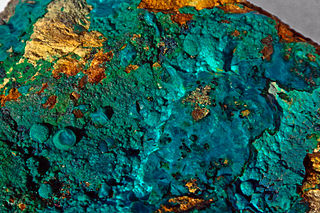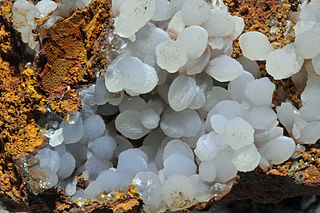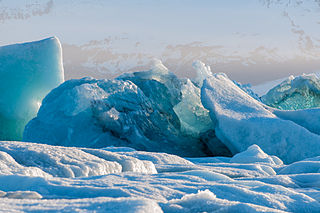|
If you're old enough to remember the sci-fi film The Matrix, then you can recall that scene at the end where Neo woke up and sees the world in codes (by the way, spoiler alert). Being a mineralogist is pretty much like that; wherever you cast your eyes, instead of phones, buildings, or cars, you will see bauxite, silica, dolomite, pyrite...etc.
It's a rather cool trick to deconstruct the world as we live through it. And it's a skill that's easily learned; though not as easy as by plugging your brain straight into the Matrix (spoiler alert, again). |
"Each of the grains of this stone, each mineral of this mountain full of darkness, forms by itself a world."
Albert Camus (1913 - 1960) novelist, playwright, philosopher
Minerals are substances that are formed naturally in the Earth. Minerals are usually solid, inorganic, have a crystal structure, and form naturally by geological processes. A mineral can be made of single chemical element or more usually a compound. There are over 4,000 types of known minerals. Two common minerals are quartz and feldspar.
A mineral is a substance that usually is an inorganic solid. (elemental mercury is an exception), has a definite chemical make-up usually has a crystal structure; some do not, and is formed naturally by geological processes.
One recent definition is: "A mineral is a homogeneous naturally occurring substance with a definite but not necessarily fixed chemical composition. Most minerals are solids with an ordered atomic arrangement, and most are inorganic in the chemical sense of that word."
Minerals and Rocks
Minerals are different from rocks. A mineral is a chemical compound with a given composition and a defined crystal structure. A rock is a mixture of one or several minerals, in varying proportions.
A rock has only two of the characteristics minerals have–it is a solid and it forms naturally. A rock usually contains two or more types of minerals. Two samples of the same type of rock may have different kinds of minerals in them. Minerals are always made up of the same materials in nearly the same proportions. A ruby is a mineral. Therefore, a ruby found in India has similar makeup as a ruby found in Australia.
Minerals are formed by natural processes. A few substances with the same chemical composition as minerals can be produced by living creatures as part of their shells or bones. The shells of molluscs are composed of either calcite or aragonite, or both.
Traditionally, chemicals produced by living things are not considered minerals. However, it is difficult to see why an organic substance should not be called a mineral if its chemical nature and its crystalline structure is identical with its inorganic twin. However this issue is now under debate.
Minerals form in many ways. The mineral halite, which is used as table salt, forms when water evaporates in a hot, shallow part of the ocean, leaving behind the salt it contained. Many types of minerals are made when molten rock, or magma cools and turns into a solid. Talc, a mineral that can be used to make baby powder, forms deep in Earth as high pressure and temperature causes changes in solid rock.
The extraordinary thing is, that most minerals owe their formation to life, or at least to the Great Oxygenation Event. "Sturdy minerals rather than fragile organic remains may provide the most robust and lasting signs of biology".
And another thing, a mineral is always a solid. That is, it has a definite volume and a rough shape. Volume refers to the amount of space an object takes up. For example a golf ball has a smaller volume than a baseball, and a baseball has a smaller volume than a basketball.
A substance that is a liquid or a gas is not a mineral. However, in some cases its solid form is a mineral. For instance, liquid water is not a mineral, but ice is.
Chemical Properties
Each mineral has a definite chemical makeup: it consists of a specific combination of atoms of certain elements. An element is a substance that contains only one type of atom.
Scientists can classify minerals into groups on the basis of their chemical makeup. Though there are thousands of different minerals, only about 30 are common in Earth's crust. These 30 minerals make up most rocks in the crust. For that reason, they are called rock-forming minerals.
Silicates are most common group. All the minerals in this group contain oxygen and silicon—the two most common elements in Earth's crust—joined together. Silicates may include other elements such as aluminium, magnesium, iron and calcium. Quartz, feldspar, and mica are common silicates.
Carbonates are the second most common group of rock-forming minerals is the carbonates. All the minerals in this group contain carbon and oxygen joined together. Calcite, which is common in seashells, is a carbonate mineral.
Oxides include the minerals from which most metals, such as tin and copper, are refined. An oxide consists of an element, usually a metal, joined to oxygen. This group includes haematite, a source of iron.
Sulphates contain the sulphate group SO4. Sulphates commonly form in evaporites where highly salty waters slowly evaporate, allowing sulfates and halides to precipitate where the water evaporates. Sulphates also occur where hot waters are forced through the rock, as with geysers.
A mineral is a substance that usually is an inorganic solid. (elemental mercury is an exception), has a definite chemical make-up usually has a crystal structure; some do not, and is formed naturally by geological processes.
One recent definition is: "A mineral is a homogeneous naturally occurring substance with a definite but not necessarily fixed chemical composition. Most minerals are solids with an ordered atomic arrangement, and most are inorganic in the chemical sense of that word."
Minerals and Rocks
Minerals are different from rocks. A mineral is a chemical compound with a given composition and a defined crystal structure. A rock is a mixture of one or several minerals, in varying proportions.
A rock has only two of the characteristics minerals have–it is a solid and it forms naturally. A rock usually contains two or more types of minerals. Two samples of the same type of rock may have different kinds of minerals in them. Minerals are always made up of the same materials in nearly the same proportions. A ruby is a mineral. Therefore, a ruby found in India has similar makeup as a ruby found in Australia.
Minerals are formed by natural processes. A few substances with the same chemical composition as minerals can be produced by living creatures as part of their shells or bones. The shells of molluscs are composed of either calcite or aragonite, or both.
Traditionally, chemicals produced by living things are not considered minerals. However, it is difficult to see why an organic substance should not be called a mineral if its chemical nature and its crystalline structure is identical with its inorganic twin. However this issue is now under debate.
Minerals form in many ways. The mineral halite, which is used as table salt, forms when water evaporates in a hot, shallow part of the ocean, leaving behind the salt it contained. Many types of minerals are made when molten rock, or magma cools and turns into a solid. Talc, a mineral that can be used to make baby powder, forms deep in Earth as high pressure and temperature causes changes in solid rock.
The extraordinary thing is, that most minerals owe their formation to life, or at least to the Great Oxygenation Event. "Sturdy minerals rather than fragile organic remains may provide the most robust and lasting signs of biology".
And another thing, a mineral is always a solid. That is, it has a definite volume and a rough shape. Volume refers to the amount of space an object takes up. For example a golf ball has a smaller volume than a baseball, and a baseball has a smaller volume than a basketball.
A substance that is a liquid or a gas is not a mineral. However, in some cases its solid form is a mineral. For instance, liquid water is not a mineral, but ice is.
Chemical Properties
Each mineral has a definite chemical makeup: it consists of a specific combination of atoms of certain elements. An element is a substance that contains only one type of atom.
Scientists can classify minerals into groups on the basis of their chemical makeup. Though there are thousands of different minerals, only about 30 are common in Earth's crust. These 30 minerals make up most rocks in the crust. For that reason, they are called rock-forming minerals.
Silicates are most common group. All the minerals in this group contain oxygen and silicon—the two most common elements in Earth's crust—joined together. Silicates may include other elements such as aluminium, magnesium, iron and calcium. Quartz, feldspar, and mica are common silicates.
Carbonates are the second most common group of rock-forming minerals is the carbonates. All the minerals in this group contain carbon and oxygen joined together. Calcite, which is common in seashells, is a carbonate mineral.
Oxides include the minerals from which most metals, such as tin and copper, are refined. An oxide consists of an element, usually a metal, joined to oxygen. This group includes haematite, a source of iron.
Sulphates contain the sulphate group SO4. Sulphates commonly form in evaporites where highly salty waters slowly evaporate, allowing sulfates and halides to precipitate where the water evaporates. Sulphates also occur where hot waters are forced through the rock, as with geysers.
There are many other mineral groups.
How Important Are Minerals?
The importance of minerals in everyday life is hardly recognized by the vast majority of people. The average person consumes or uses 20,000 kgs of minerals every year. Over the course of a lifetime, an individual will use more than 525 kgs of lead, 525 kgs of zinc, 875 kgs of copper, 2,275 kgs of aluminum, 45,000 kgs of iron and steel, 180,000 kgs of coal, and 500,000 kgs of industrial minerals such as limestone, clay, and gravel.
To help illustrate how important minerals are to us, perhaps a trip through a normal working day of a geologist will better explain our reliance on minerals:
As we wake up in the morning from a restless night of sleep, we turn off our alarm clock (manufactured from limestone, mica, talc, silica, and clays). After getting out of bed (bed frame and bed springs made from iron and nickel), we make our way into the kitchen. We turn on the electric light switch (copper, aluminum, and petroleum products) and the coffee pot, which is made of glass or ceramics (silica sand, limestone, talc, and feldspar).
While waiting for the coffee (coffee beans fertilized with phosphate) to brew, we sit down on a chair (aluminum and petroleum products) and read the local newspaper (kaolin clay, limestone, sodium sulfate, and soda ash). Suddenly, we develop an upset stomach. We decide to take Milk of Magnesia (magnesium and dolomite) or Kaopectate (kaolin clay) for relief of our upset stomach.
We look up at the clock (silica sand, steel, and petroleum products) and hurry upstairs on the carpeted floor (limestone, selenium, and petroleum products). We jump in the shower (made of ceramic tiles that are composed of silica sand, limestone, talc, and feldspar) and turn on the water (softened by halite). We adjust the shower head and turn the water tap (iron, nickel, chromium) for warm water. We take a quick cold shower, using soap (talc) and shampoo (coal tar, lithium clays, and selenium) to clean ourselves. We get out of the shower and brush our teeth with a toothbrush (limestone, mica, talc, clays, and petroleum products) and toothpaste (limestone, phosphate, gypsum, selenite, fluorite, and dolomite).
The truck we drive is composed of many different components that were manufactured from minerals. The tires are made from limestone and clay. All of the glass in the car is made from silica sand and feldspar. The body (including the bumper) is made from iron, limestone, mica, talc, silica, clays and petroleum products. The automobile engine and other components under the hood are made out of iron, lead, molybdenum, chromium, nickel, aluminum, and zinc. The red paint is made of titanium, kaolin clays, mica, talc, gypsum, sulfur, silica, and limestone.
At work, we decide to use our laptop computer (gold, silica, nickel, aluminum, zinc, iron, petroleum products, and thirty other minerals) and a software on CD-ROM (aluminum and petroleum products) to help guide us to the correct field location. Once we get to the field area, we begin by pulling out a field notebook (kaolin clay, limestone, and soda ash). We begin writing preliminary information, such as latitude/ longitude coordinates we obtained from our Global Positioning System (silica, mica, clay, limestone, and talc) with our pencil (graphite and clays) or pen (limestone, mica, clays, silica, talc, and petroleum products).
We see an interesting rock and decide to use our hammer (iron and nickel) and break off a chunk for analysis. For safety, we put on our safety goggles (silica, talc, clays, and mica). We get out our hand lens (iron ore and silica) and view the mineral content of the rock closely. Next, we find our hydrochloric acid (halite) to test for the calcium carbonate content of the minerals. We also pull out our ceramic scratch plate (silica sand, limestone, talc, lithium, and feldspar) to check the streak of the mineral.
Finally, we decide to use our camera (silica and petroleum products) and film (silver and petroleum products) and take several pictures of the rock outcrop. When we feel like we have analyzed the outcrop thoroughly, we load up the truck and head for home.
When we get home at night, we decide to warm up a meal in the microwave oven (silica, copper, gold, iron, and nickel) and enjoy some refreshments (filtered through perlite or diatomite). These refreshments are served in a glass or ceramic mug (silica, limestone, and feldspar). Our day ends with us falling asleep in front of the television (silica, iron, copper, aluminum, and nickel).
Everyone relies heavily on minerals to do their job and in their daily life. So, the next time you drive a car or work on the computer at the office, think about how important minerals are to us. What would we do without them?
Ponder this
If rocks are a mixture of minerals, would there not be an almost infinite type of rocks, considering the permutations of possible mixtures of minerals?
Can we create artificial "rocks"?
Discuss
Look around in your classroom. Deconstruct as much as you can by discussions and researching on how and what makes those objects in discussion. Discuss the origins, processes, and methods of how they end up from as they were to as they are.
Further readings
Mindat mineralogical database, largest mineral database on the Internet
Mineral Identification Key, from the Mineralogical Society of America
Minerals and the Origins of Life, an interesting video from the Space Telescope Science Institute















